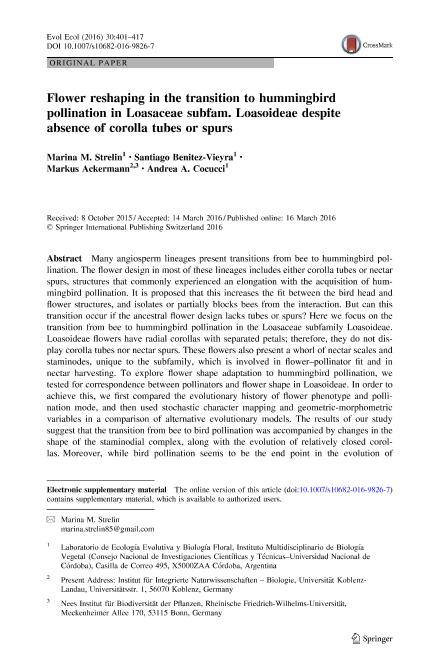Artículo
Flower reshaping in the transition to hummingbird pollination in Loasaceae subfam. Loasoideae despite absence of corolla tubes or spurs
Strelin, Marina Micaela ; Benitez-Vieyra, Santiago Miguel
; Benitez-Vieyra, Santiago Miguel ; Ackermann, Markus; Cocucci, Andrea Aristides
; Ackermann, Markus; Cocucci, Andrea Aristides
 ; Benitez-Vieyra, Santiago Miguel
; Benitez-Vieyra, Santiago Miguel ; Ackermann, Markus; Cocucci, Andrea Aristides
; Ackermann, Markus; Cocucci, Andrea Aristides
Fecha de publicación:
03/2016
Editorial:
Springer
Revista:
Evolutionary Ecology
ISSN:
0269-7653
e-ISSN:
1573-8477
Idioma:
Inglés
Tipo de recurso:
Artículo publicado
Clasificación temática:
Resumen
Many angiosperm lineages present transitions from bee to hummingbird pollination. The flower design in most of these lineages includes either corolla tubes or nectar spurs, structures that commonly experienced an elongation with the acquisition of hummingbird pollination. It is proposed that this increases the fit between the bird head and flower structures, and isolates or partially blocks bees from the interaction. But can this transition occur if the ancestral flower design lacks tubes or spurs? Here we focus on the transition from bee to hummingbird pollination in the Loasaceae subfamily Loasoideae. Loasoideae flowers have radial corollas with separated petals; therefore, they do not display corolla tubes nor nectar spurs. These flowers also present a whorl of nectar scales and staminodes, unique to the subfamily, which is involved in flower–pollinator fit and in nectar harvesting. To explore flower shape adaptation to hummingbird pollination, we tested for correspondence between pollinators and flower shape in Loasoideae. In order to achieve this, we first compared the evolutionary history of flower phenotype and pollination mode, and then used stochastic character mapping and geometric-morphometric variables in a comparison of alternative evolutionary models. The results of our study suggest that the transition from bee to bird pollination was accompanied by changes in the shape of the staminodial complex, along with the evolution of relatively closed corollas. Moreover, while bird pollination seems to be the end point in the evolution of pollination syndromes in many angiosperm lineages, rodent pollinated flowers probably evolved from ancestral bird pollinated flowers in Loasoideae. Our findings suggest that the evolution of bird pollinated flowers from ancestral bee pollinated flowers does not require the presence of corolla tubes or spurs, and can take place as long as the flower design includes structures participating in flower–pollinator fit.
Archivos asociados
Licencia
Identificadores
Colecciones
Articulos(IMBIV)
Articulos de INST.MULTIDISCIPL.DE BIOLOGIA VEGETAL (P)
Articulos de INST.MULTIDISCIPL.DE BIOLOGIA VEGETAL (P)
Articulos(INIBIOMA)
Articulos de INST. DE INVEST.EN BIODIVERSIDAD Y MEDIOAMBIENTE
Articulos de INST. DE INVEST.EN BIODIVERSIDAD Y MEDIOAMBIENTE
Citación
Strelin, Marina Micaela; Benitez-Vieyra, Santiago Miguel; Ackermann, Markus; Cocucci, Andrea Aristides; Flower reshaping in the transition to hummingbird pollination in Loasaceae subfam. Loasoideae despite absence of corolla tubes or spurs; Springer; Evolutionary Ecology; 30; 3; 3-2016; 401-417
Compartir
Altmétricas



